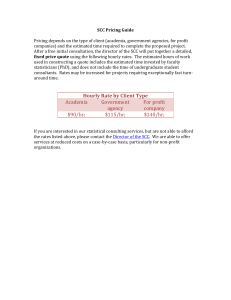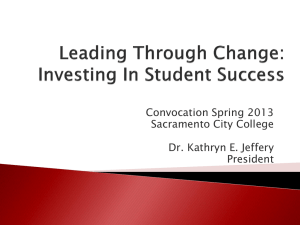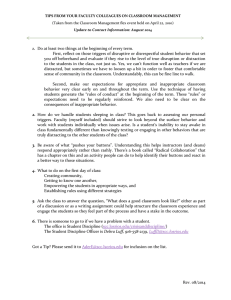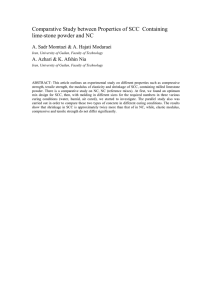S C 2013-14 Achievements
advertisement
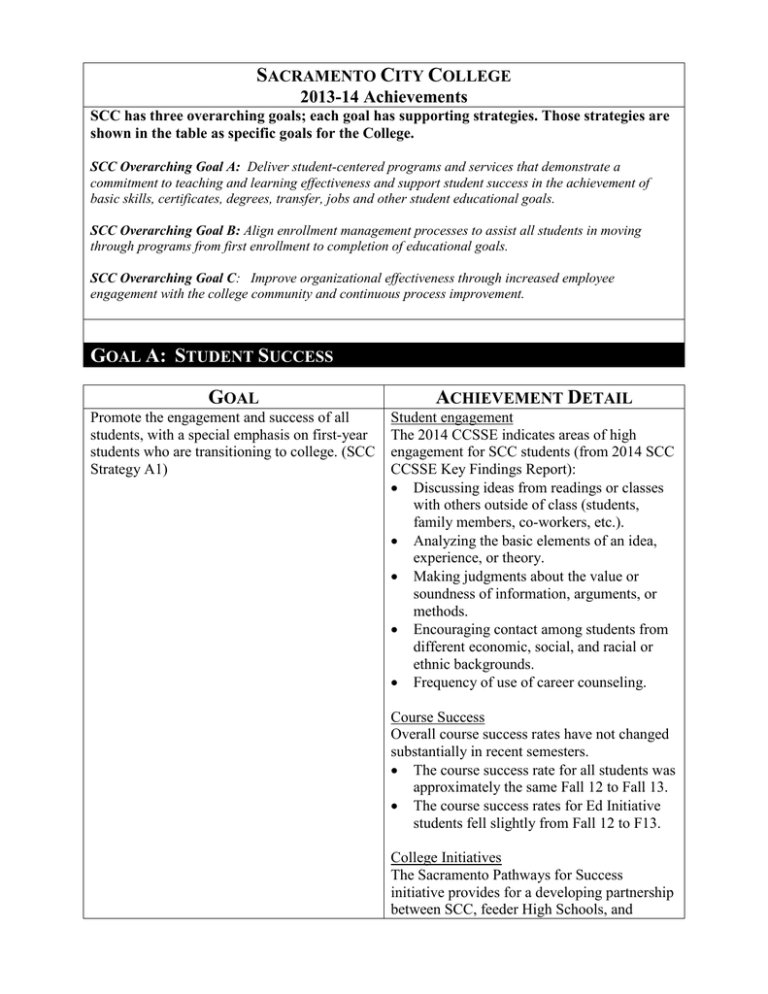
SACRAMENTO CITY COLLEGE 2013-14 Achievements SCC has three overarching goals; each goal has supporting strategies. Those strategies are shown in the table as specific goals for the College. SCC Overarching Goal A: Deliver student-centered programs and services that demonstrate a commitment to teaching and learning effectiveness and support student success in the achievement of basic skills, certificates, degrees, transfer, jobs and other student educational goals. SCC Overarching Goal B: Align enrollment management processes to assist all students in moving through programs from first enrollment to completion of educational goals. SCC Overarching Goal C: Improve organizational effectiveness through increased employee engagement with the college community and continuous process improvement. GOAL A: STUDENT SUCCESS GOAL ACHIEVEMENT DETAIL Promote the engagement and success of all students, with a special emphasis on first-year students who are transitioning to college. (SCC Strategy A1) Student engagement The 2014 CCSSE indicates areas of high engagement for SCC students (from 2014 SCC CCSSE Key Findings Report): Discussing ideas from readings or classes with others outside of class (students, family members, co-workers, etc.). Analyzing the basic elements of an idea, experience, or theory. Making judgments about the value or soundness of information, arguments, or methods. Encouraging contact among students from different economic, social, and racial or ethnic backgrounds. Frequency of use of career counseling. Course Success Overall course success rates have not changed substantially in recent semesters. The course success rate for all students was approximately the same Fall 12 to Fall 13. The course success rates for Ed Initiative students fell slightly from Fall 12 to F13. College Initiatives The Sacramento Pathways for Success initiative provides for a developing partnership between SCC, feeder High Schools, and CSUS. Initiatives have been developed across the college to increase the engagement and success of new students. Examples include: The SAH Division developed an alternative model for a Geology dual enrollment course with Rosemont H.S. in which students take a high school level Geology course immediately before taking our college course. The SAH division, with support from Health Workforce Initiative, developed a Community of Practice that includes three instructors, a counselor and administrator from SCC and from two feeder H.S.(Health Professions and River City), with the goal of improving the transition from H.S. to college. Student Leadership and Development collaborated with “Freshmen Welcome” to incorporate activities from “Week of Welcome” (WOW) with SLD’s Welcome Day activities to help new students gain a sense of identity with their campus and to promote student engagement. SLD collaborated with the “Senior Saturday” program to offer participating high school seniors an opportunity to meet members from 10 campus clubs and learn more about our campus life activities at the SLD information booth. SLD also provided live musical performances and a trivia contest (SLD gave away prizes) to promote student engagement and diversity. Review courses, programs and services and modify as needed to enhance student achievement. (SCC Strategy A2) Partially achieved Courses and Programs SOCRATES reports for SCC show that in the 13-14 academic year, 565 courses and 103 programs were reviewed; many were modified to enhance student achievement. This includes modifications related to program review, the new repeatability policies, SLOs assessment results, etc. Program reviews were completed for instructional programs according to the Instructional Program Review Calendar. Services Student services and support programs have been modified to enhance student achievement. Examples include: The Human Career Development Institute held January 15, 2014 to address curricular overlap between instructors. The Los Rios Study Abroad Program reviewed and enhanced the processes and procedures that governed our participation. It succeeded in increasing student participation from an average of 4 to 5 students to a total of 21 in one semester. Student Services conducted a comprehensive set of Program Reviews across the College Service Area. Provide students with the tools and resources that they need to plan and carry out their education, complete degrees and certificates, and/or transfer. (SCC Strategy A3) Achieved Degrees and Certificates Awarded Preliminary data indicate that SCC awarded 1684 degrees in 2013-14, an increase from the 1480 awarded in 2012-13. For certificates, there was a slight decrease form 536 for 201213 to 499 for 2013-14. Transfer The percent of students who were transfer ready increased from Fall 12 to Fall 13. (Other transfer data for 13-14 not yet available). College Initiatives Innovative approaches to improving student completion were implemented. Examples include: Group counseling/ISEP completion was done for students in the Business and Computer Information Science Division. The SSSP plan is nearing completion. Improve basic skills competencies in reading, writing, math, and information competency across the curriculum in order to improve student preparedness for degree and certificate courses and for employment. (SCC Strategy A4) Partially achieved Scorecard Metrics The 2014 Scorecard shows an increase in Remedial English Progression in the most recent cohort. The metrics for Remedial Math Progression was relatively unchanged and Remedial ESL progression declined slightly. College Initiatives The “Second Chance Algebra” program resulted in approximately 50% of participants (40 students) successfully completing the course. The “Second Chance Statistics” program resulted in 10 of 10 students passing Statistics in the fall 2013 and 9 of 10 passing Statistics in the spring 2014. The Math “Pass that Class” program resulted in three of four algebra groups having higher pass rates than the total student population enrolled in those classes.(70 students enrolled during 13-14) Following the introduction of a new compressed English composition sequence a slightly higher percentage of students who started at the beginning of the sequence progressed through it and attempt ENGWR 300. Implement practices and activities that reduce achievement gaps in student success. (SCC Strategy A7) Partially achieved Course success The gap in course success rates between age groups has declined from 6.4% in Fall 2012 to 3.5% in Fall 2013. The gap in course success rate between ethnic groups has not changed substantially. The three EOPS Math Cohorts demonstrate a higher success rate for students than the regular classes. College Initiatives African American students enrolled in Learning, Tutoring and Academic Technology (LTAT) courses in higher numbers than in the SCC population overall and slightly higher than the division taken as a whole. SCC is participating in the CCSSE/NSSE Engaging Latino Students project. Implement a formal college-wide plan to increase the completion of degrees and certificates across the college. (SCC Strategy A9) Achieved This plan was subsumed into the new SSSP plan. The SSSP plan for the college is nearing completion. Achieved COLLEGE / UNIT NAME 2013-14 Desired Outcomes GOAL B: TEACHING AND LEARNING EFFECTIVENESS GOAL Deliver services, curriculum, and instruction that result in equivalent student outcomes for all modalities and locations. (A5) ACHIEVEMENT DETAIL Locations – Course success Course success rates for the main campus and the centers are very similar. Locations – College services A course coordinator for ENGWR 157 worked with the Davis Center to develop an expanding program (added nineteen sections) with strong student success. The Davis Center successfully offered a variety of faculty and staff events during flex week and throughout the year. Modalities - Course success Course success rates for online courses are similar to those for face-to-face courses. Hybrid courses which are less than 50% DE have lower course success rates than face-toface courses. The SCC DE Committee is reviewing DE course success rates in order to suggest ways to reduce gaps. Modalities – College services Equivalent services are available for both on campus and DE students. The College Catalog and schedule of classes are available online. Students are able to apply to SCC and register for classes by using “eServices” which is reached from the Online Services webpage. Through eServices, students are able to add and drop classes, pay for classes and purchase parking permits online. Three online CIS classes were chosen to pilot online counseling The SCC DE Committee is reviewing processes and practices related to DE with the goal of providing support and training to faculty teaching the courses and services to students taking the courses. Identify and disseminate information about teaching practices and curriculum that are effective for a diverse student body. (A6) Assess student learning at the course, program, and institutional levels and use those assessments to make appropriate changes that support student achievement. (A8) Partially achieved Staff development SCC has a strong staff development program related to effective teaching for a diverse student body. Examples include: The Staff Resource Center offers a wide array of flex workshops related to teaching practices. Evaluations of those workshops indicate high satisfaction by attendees. Faculty members of the AHLC have engaged in a number of efforts to disseminate information about teaching practices to the broader campus community. Flex activities in the Davis Center focused on “Who Are Our Students?” and “Student Success Across the Curriculum”—how we can work together to ensure that students see connections among courses and build their knowledge as they complete their programs. Achieved SLO assessment 65.3% percent of college programs have ongoing assessment of learning outcomes. 94.3% percent of college courses have ongoing assessment of learning outcomes. 86.4% percent of student and learning support activities have ongoing assessment of learning outcomes. Use of assessment of student learning for improvement. Over 100 unit plan objectives for 2013-14 used SLO data. These objectives were related to all three College Goals. The great majority (88%) of the objectives that used SLO data were fully or partially accomplished during the 2013-14 academic year. Many objectives that were not accomplished have end years of 2014-15 or later. Faculty and staff dialogue Faculty and staff discuss student learning and use that information to make changes. Examples include: Math faculty schedule regular meetings to discuss the results of SLO assessments and evaluations, all in an effort to improve student success. The Student Learning Outcomes Assessment Committee (SLOAC) meets regularly to discuss SLO assessment processes. The PRIE Office and SLO Coordinator produce an annual Institutional Effectiveness Report on SLOs. Partially achieved COLLEGE / UNIT NAME 2013-14 Desired Outcomes GOAL C: ACCESS AND GROWTH GOAL ACHIEVEMENT DETAIL Use quantitative and qualitative data to identify PRIE data strategies which improve enrollment Enrollment data is provided via a website that management processes. (B2) is updated daily by PRIE. Demonstrated use of data related to enrollment management was shown by a PRIE survey Conducted in Fall 2013. The greatest number of respondents had worked with PRIE on unit planning, enrollment data, descriptive student data, and student success data. Master Plans The Education Master Plan has been updated and will be available early in Fall 2014. The VPI Office works with all instructional departments to manage enrollment. The Student Services Master Plan update will be completed during Fall 2014. Explore and create multiple ways to disseminate information to students in order to engage them with learning in the college community. (B3) Support “front door” policies and practices that assist students with the transition to college. (B4) Achieved College initiatives SCC has developed a variety of ways to disseminate information to students and engage them with the college. Examples include: The iSEP has been implemented Revision of the college website. “411 for Success” bookmarks and folders have been printed for first time college students. The English and Journalism Departments sent letters to all students listed as majoring in those disciplines, offering them information about SCC’s offerings and the benefits of majoring in those areas. The BUS/CIS Division added a Twitter account to inform students about class openings, events on campus, and other relevant information. Achieved The recommendations of the Student Success Act have been implemented. SCC has implemented policies and practices that support student use of “front door” services. Examples include: The provisions of the State policies related to the SSSP are being implemented. In Fall 2013 Student Services Feedback Cards showed 80% satisfaction rate for the student’s front counter experience during the first two weeks of the semester; 83% excellent rating for quality of services received overall and 78% satisfaction with extent to which student’s needs were met. Maintain the quality and effectiveness of the physical plant in order to support access and success for students (i.e. modernization, TAP improvements, equipment purchases, etc.). (B5) Preview Night was held Oct. 30th to provide incoming students and their parents an opportunity to explore SCC certificate and degree programs. Approximately 600 people attended. The SAH Division has obtained funding to support the formation of a community of practice in collaboration with two area high schools (River City H.S. of the Washington USD and Health Professions H.S. of the Sacramento City USD) focused on how to ease the transition of high school students to college. Students Obtaining Success (SOS) tables the first three days of the semester assist students with directions, general information and answering any questions they may have. In Fall 2013 at the oncampus SOS sites, 58 SCC students, staff, faculty and managers served 8005 students. Achieved SCC physical plant Facilities are adequately maintained as a result of coordination efforts between the college and district Facilities Management staff. Progress on construction and modernization projects is ongoing. SCC’s Long Range Capital Needs Plan (LRCNP) related to new construction and modernizations projects continues to be updated and implemented. Achieved COLLEGE / UNIT NAME 2013-14 Desired Outcomes GOAL D: COMMUNITY, ECONOMIC, AND WORKFORCE DEVELOPMENT GOAL ACHIEVEMENT DETAIL Revise or develop courses, programs, schedules and services based on assessment of emerging community needs and available college resources. (B1) New or revised courses and programs: SOCRATES reports for SCC show that in the 13-14 academic year, 565 courses and 103 programs were reviewed. This includes modifications related to community needs. For example, 22 Associate Degrees for transfer have been developed. Student services and support programs have been modified to enhance student achievement. Examples include: The Human Career Development Institute held January 15, 2014 to address curricular overlap between instructors. The Los Rios Study Abroad Program reviewed and enhanced the processes and procedures that governed our participation and succeeded in increasing student participation from an average of 4 to 5 students to a total of 21 in one semester. Expand interactions with community and industry partners in order to increase student opportunities for experiences that help them transition to careers (career exploration, completion of licenses, internships, etc.) (B6) Achieved Pathways and partnerships: K-12, community and industry partnerships include: Sacramento Pathways for Success 2+2+3 Law School Pathway Deputy Sector Navigator at SCC both CRANE and CAP programs “Move the Workforce Needle” work of the Business Division Allied Health Learning Community CCSSE/NSSE Engaging Latino Students Partnership. Transition to careers: College initiatives have addressed student transition to careers. Examples include: A grant was received to help cover the cost of some licensure exams for students in CIS. These credentials are highly sought in in the workplace, and bringing down or eliminating the cost to students is expected to increase the number of students who sit for these exams. Deans from all four BUS and CIS Divisions have begun plans to conduct joint Advisory Board meetings, faculty workshops for flex, and other activities to better streamline processes for students across the district. Licenses: Seventeen of the 19 CTE programs with licensure exams have pass rates of over 80%. Twelve have pass rates of 95% or higher. Provide students with clear pathways to goal completion. (B7) Achieved SSSP: SCC is restructuring of the Matriculation Program to become the Student Success and Support Program. The College’s SSSP plan is near completion. The iSEP has been implemented. Degrees: AA-T and AS-T degrees have been developed. SCC now has 22 Associate Degrees for Transfer. Course sequences Pre-requisite predictive validation implementation studies have been conducted for Spanish 401; SOC 300, 301, 321; ESLW to ENGWR “bridge”, and enrollment limitations for the PTA program. Pre-req consequential validation studies have been conducted or are in progress for BUS 100, 310, 320; HIST 300, 302, 307, 308, 309, 310, 311, 314, 320, 321, 344, 360, 364, 365, 373, 375, 380 and for the Chemistry placement exam (for CHEM 400). A new compressed English composition sequence was implemented Partially achieved COLLEGE / UNIT NAME 2013-14 Desired Outcomes GOAL E: ORGANIZATIONAL EFFECTIVENESS GOAL ACHIEVEMENT DETAIL Review staff processes, including those for hiring, orientation, training, customer service, evaluation and professional development and modify as needed in order to make them more effective and inclusive. (C1) VPA processes: The VPA office tracks staff processes through annual program review and quarterly metric assessments of key management areas related to classified personnel. These metrics indicate that staff processes are effective. Staff Development Evaluation surveys of staff development workshops by attendees indicate high satisfaction. Areas across the campus have supported effective staff development. Examples include: The SAH Division through its class scheduling strategy developed a true “college hour” to provide faculty more opportunities to attend PD and to interact with each other as a method of professional learning. New staff development activities for classified staff have been implemented. Build and maintain an effective staff that reflects the diversity of our students and community. (C2) Achieved College processes: Staffing requests have been effectively prioritized. New hires have been requested, prioritized, and hired in a timely fashion. Over the past 5 years the percentage of White Non-Hispanic employees at SCC has decreased and the number of Hispanic employees has increased by over 3 percentage points. SCC programs and activities support staff effectiveness and diversity. For example: The Staff Resource Center has offered activities related to the diversity of students and community. The Cultural Awareness Center has worked in collaboration with faculty across the curriculum to coordinate a wide range of CAC programs. Equity training was provided for campus employees. Equity Officer: Addressed 56 student complaints, 2 staff/faculty complaints, Addressed 6 staff/faculty Requests for Accommodations. In the 13-14 academic year, the Equity Officer doubled the number of workshops on equitable hiring from the previous year, including division-specific workshops on request. In the 13-14 academic year, the Equity Officer provided equity training, upon request, to the campus police officers and facilities maintenance staff. These trainings focused on equitable behaviors in the workplace, rather than on hiring processes. Achieved Promote health, wellness and safety throughout College initiatives: the institution. (C3) Health, wellness and safety have been promoted throughout the institution. For example: New environmental standards related to smoking areas have been instituted at the college. College President Kathryn Jeffery has begun a new health initiative called “Come Walk With Me”. A subcommittee of the Safety Committee was created by President Jeffery to investigate ways to create a healthier campus. SCC staff participated in the LRCCD health improvement challenges. A number of activities offered by the Staff Resource Center related to health and wellness were offered. Health Services is implementing a campus campaign to reduce smoking. Last year SCC led the district in member participation and in team rankings for Kaiser Thrive teams. Utilize quantitative and qualitative data to help guide decision-making throughout the institution. (C4) Achieved College processes: The operational work of college units is based on data: Unit planning data includes student demographics, enrollment, success, and achievement information. Program plans include data on measures of merit for the program. Institutional plans include appropriate data analysis. Tutoring services collect and use student survey data to improve processes. Program reviews include data on student demographics, enrollment, success, SLO achievement, and achievement of degrees and certificates. Pre-requisites are selected for courses based on data analyses. The Basic Skills Initiative committee evaluates the effectiveness of interventions to increase student achievement. The SCC Institutional Effectiveness Reports are utilized across the college. PRIE conducted a feedback survey in Fall 2013. The greatest number of respondents had worked with PRIE on many types of data, most commonly unit planning, enrollment data, descriptive student data, and student success data. Increase the effectiveness of communication both within the college and between the college and the external community. (C5) Achieved College processes: The college website has been redesigned. There has been increased departmental use of technology for communication (websites, Facebook use, etc.) The college Viewbook and Tabloid are being updated. Increased communication with residents of Davis and West Sacramento is being implemented. The Communication Council is working effectively sharing information between colleges. Continue to exercise transparent and fiscally sound financial management. (C6) Partially achieved Budget metrics Budget metrics demonstrate continued fiscal soundness. SCC has weathered the budget crisis well. The college is poised to grow in the 2014-15 year. Solid procedures in place have served the college well over these past several years. Categorical funds are being integrated into the SCC resource allocation process. For example, Student Services completion of a Matriculation Program Plan presented to the President’s Cabinet in Dec. 2013 for more transparent categorical integration throughout college in FY 2014-15 Ongoing college costs and program plan allocations were adequately funded with sufficient funds remaining to provide for unit plan requests for new resources. Unit plans: Most 2013-14 unit plan objectives associated with resource requests were accomplished. Those with financial resource requests had the highest percentage of objectives accomplished or partly accomplished (65%); those with requests to hire permanent classified staff had the lowest percentage of objectives accomplished or partially accomplished (41%). Many objectives that were not accomplished have end years of 2014-15 or later. Encourage collegiality, connection, and participatory decision-making at the college. (C7) Achieved College processes: The Campus Issues Process was utilized effectively in the 2013-14 academic year. Examples include: Development of a Sustainability Planning Committee Implementation of new environmental standards with respect to smoking on campus. Change of the name of the Business Division to the Business & Computer Science Division PRIE conducted a feedback survey in Fall 2013 which demonstrated that participation data based planning is common across the college. Effective planning processes occur at the department, division, CSA, and college levels. Action supporting this include: The Spring 2014 convocation activities that included a campus-wide charette on student success strategies. The SCC college community is widely engaged in developing the Accreditation Self-Evaluation. During Summer 2014 a number of staff development activities were offered specifically for classified staff. A Planning Handbook has been developed for use beginning Fall 2014. The SAH Division has launched a Divisionwide process that will provide chairs with monthly financial reports in order to improve the visibility of financial decisions and improve the Unit Plan process. Partially achieved

